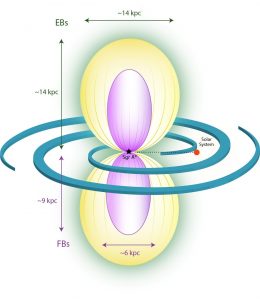Detection of large-scale eROSITA bubbles in the halo of the Milky way

The eROSITA bubbles. The false-colour map shows extended emission at energies of 0.6-1.0 keV. The contribution of the point sources was removed and the scaling adjusted to enhance large-scale structures in our Galaxy. © MPE/IKI

Schematic view of the eROSITA (yellow) and Fermi bubbles (purple). The galactic disk is indicated with its spiral arms and the location of the Solar System is marked. The bubble structures are comparable in size to the whole galaxy. © MPE
The first all-sky survey by the eROSITA X-ray telescope revealed the entire X-ray Universe with unprecedented detail in June 2020. The study of one particularly interesting feature, the large-scale “eROSITA bubbles” in the halo of the Milky Way, has now been published in Nature.
What has been named “eROSITA bubbles” are large-scale structures in the shape of an hourglass that seem to be centered on the center of our galaxy and the show a striking similarity to the Fermi bubbles, which have been detected about a decade ago at gamma-ray energies. The bubbles in the X-rays are highlighted in the false-color map on the right, which shows extended emission at energies from 0.6 to 1 keV. These structures are produced by shocks in the hot gas envelope of our galaxy, which most likely have been produced by a massive energy output from the central Galactic region.
In comparison to the Fermi bubbles, the “eROSITA bubbles” are even larger and extend over a distance equal to the size of our galaxy (see the Schematic view on the right). The large-scale disturbances in the hot gas envelope could have been caused either by a burst of star formation or an outburst from Srg A*, the central supermassive black hole in the Galactic Centre.
Although the black hole is dormant now, it might have been active in the past. The energy needed to power the formation of the bubbles is estimated to be equivalent to the energy released by 100,000 supernovae, which is similar to the power output of active galactic nuclei.
Further information
- FAU press release (DE/EN)
- MPE press release (DE/EN)
- Original publication in Nature: Detection of large-scale X-ray bubbles in the Milky Way halo
For more information about eROSITA and the X-ray sky, please contact:
Manami Sasaki
Manami.Sasaki@fau.de
+49 9131 85-81019
Jörn Wilms
Joern.Wilms@sternwarte.uni-erlangen.de
+49 9131 85-81013





